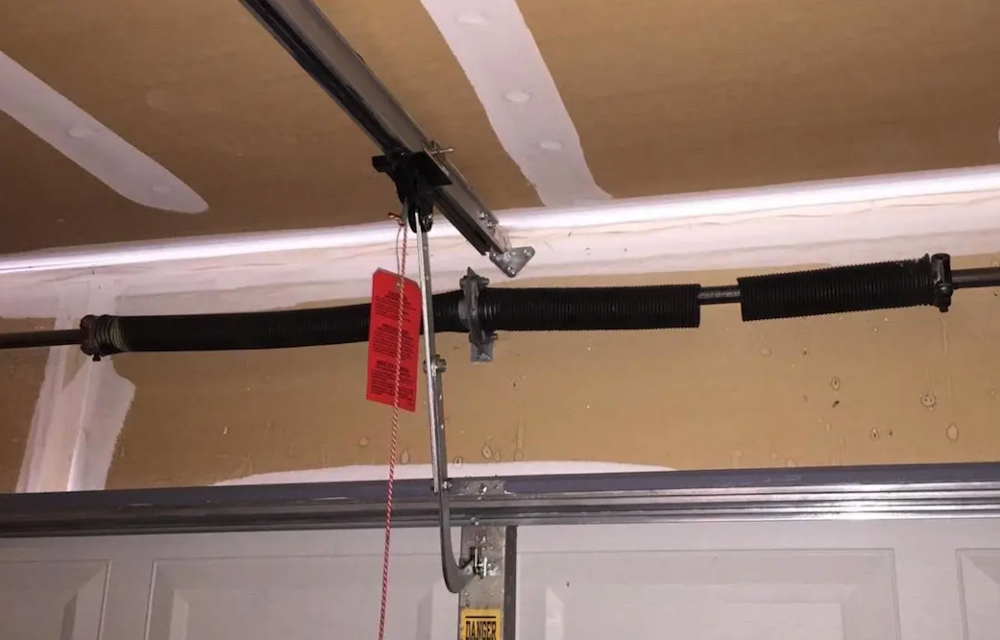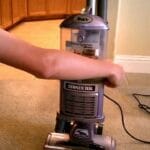You arrive home after a long day, ready to relax, but your garage door won’t budge. The culprit?
A broken spring. It’s frustrating, inconvenient, and maybe even a little daunting. But don’t worry—you can still open your garage door safely and effectively. You’ll learn simple steps to handle this common problem without damaging your door or straining yourself.
Imagine regaining control quickly, avoiding costly repairs, and saving time. By understanding these steps, you’ll ensure your garage door operates smoothly, even when it’s not in perfect condition. Dive into the practical tips and expert advice that will empower you to tackle a broken spring head-on. Your garage door solution is just a few scrolls away.

Credit: www.doorvana.com
Safety Precautions
Opening a garage door with a broken spring can be dangerous. Taking the right safety precautions is essential. This ensures you and your property stay safe. Understanding what to do can prevent accidents and injuries.
Assessing The Situation
First, observe the garage door carefully. Look for visible damage or potential hazards. Check if the door is off its tracks or hanging unevenly. Listen for unusual noises when attempting to open it. Identify any tension in the cables or pulleys. This helps determine the severity of the issue.
Protective Gear
Wear safety gloves to protect your hands. Use safety goggles to shield your eyes from flying debris. Consider wearing a hard hat for additional protection. Proper footwear with a good grip can prevent slips. Ensure your clothing is snug to avoid getting caught in moving parts.
Identifying Spring Types
Broken springs can make opening a garage door tricky. Identify the spring type first. Torsion or extension springs need different handling. Always ensure safety when diagnosing and fixing garage door issues.
Opening a garage door with a broken spring can be a real hassle, especially if you’re not sure what type of spring you’re dealing with. Identifying the spring type is the first step to finding a solution. Knowing whether your garage door has torsion or extension springs will guide you in repairing or replacing them effectively. You’ll save time and possibly money by knowing what you’re working with.Torsion Springs
Torsion springs are mounted horizontally above the garage door. They twist and coil around a metal rod to create tension. This tension is released to lift the door smoothly. Torsion springs are generally more durable and can handle heavier doors. Have you noticed a metal rod running parallel above your garage door? If yes, you likely have torsion springs. These springs are known for providing a balanced lifting motion. If your door feels uneven or jerky, the torsion spring may be broken.Extension Springs
Extension springs are located on either side of the garage door. They stretch along the horizontal tracks to create tension. These springs are often more affordable but might not last as long as torsion springs. Do you see long springs running parallel to the door tracks? These are extension springs. They expand and contract as the door moves. If your garage door struggles to stay open, the extension spring might be the culprit. Both spring types have their pros and cons. Torsion springs offer durability, while extension springs are easier on the pocket. Identifying the type will help you choose the right repair method. So, next time your garage door gives you trouble, take a closer look at the springs. What can you learn about your garage door just by observing the springs?Gathering Necessary Tools
Opening a garage door with a broken spring requires careful preparation. Gathering the right tools is essential for safety and efficiency. You’ll need some basic tools and a few specialized items. Knowing exactly what to gather can make the process smoother and less stressful.
Basic Tools Required
Start with a sturdy ladder. It helps you reach and inspect the door mechanism. Grab a set of pliers. They assist in gripping and handling small parts. A screwdriver is necessary to remove and tighten screws. Keep a wrench handy. It’s useful for loosening and tightening bolts. Safety goggles protect your eyes from debris. Gloves safeguard your hands during the process.
Specialized Equipment
Consider getting a winding bar. It’s crucial for handling torsion springs safely. A clamp is useful for securing the garage door, preventing accidental movements. A drill can speed up the process, especially if screws are stubborn. Spring replacement kits often include necessary components for fixing the door. These kits sometimes come with instructions for easy understanding. Ensure you have the right size spring for your garage door.
Manual Operation Techniques
Opening a garage door with a broken spring requires caution and technique. Ensure safety by disconnecting the opener. Then, lift the door evenly with help if needed.
Opening a garage door with a broken spring can be a frustrating challenge, especially when you’re in a hurry. However, it’s not as daunting as it may seem if you know the right manual operation techniques. These methods enable you to safely and effectively open your garage door without causing further damage or risking injury. Let’s dive into some practical steps you can take to manage this task.Disengaging The Opener
Before you start, you need to disengage the automatic opener. This is crucial because trying to lift the door with the opener engaged can damage the motor and the door itself. Look for a red cord or handle hanging from the center rail of your garage door opener. Pull down on this emergency release handle to disconnect the door from the automatic opener. You’ll hear a click that indicates the door is now in manual mode. Tip: Do this gently to avoid snapping the cord.Lifting The Door Safely
Once disengaged, you’re ready to lift the door manually. It’s important to lift the door with your knees, not your back, to prevent injury. Stand with your feet shoulder-width apart, and grip the door with both hands. Lift slowly and steadily. If the door feels too heavy, don’t force it—this could be a sign of a more serious issue. Consider enlisting a friend or neighbor to help. Did you know: Many people injure themselves by attempting to lift without proper support? Always ensure the door is securely held in place once opened. You can use a sturdy object to prop it open if necessary, but make sure it’s stable. These manual operation techniques are not just quick fixes; they’re essential skills that can save you time and stress. Have you tried these methods before? What was your experience?Temporary Solutions
Having a broken garage door spring can be frustrating. It can disrupt your day and compromise home security. While waiting for a professional repair, there are temporary solutions. These methods help manage the situation safely. Ensure you take necessary precautions to avoid injury.
Securing The Door
One of the first steps is securing the door. This prevents it from accidentally closing. Use a sturdy piece of wood or a metal bar. Place it in the door track. It acts as a stopper. This prevents the door from moving unexpectedly. Make sure the door is closed completely before doing this. Always ensure your safety first.
Using A Ratchet Strap
A ratchet strap can provide temporary support. It helps keep the door in place. Attach one end to the door handle. Secure the other end to a strong anchor point. This could be a wall bracket or a garage beam. Tighten the strap carefully. Ensure it’s snug, but not overly tight. This method prevents the door from falling suddenly. Use caution when adjusting the strap. Always prioritize safety over convenience.

Credit: www.garagedoorspecialist.net
Professional Repair Options
Fixing a garage door with a broken spring requires professional help. Attempting repairs yourself can be dangerous. Professionals have the tools and expertise needed. Hiring them ensures safety and efficiency. Let’s explore how you can choose the right service.
Hiring A Technician
Find a qualified technician with good reviews. Experience matters. Check their credentials and past work. Ask friends for recommendations. A professional will diagnose the problem accurately. They will also provide long-lasting solutions. Make sure they have the right tools for the job.
Cost Considerations
Repair costs depend on the damage extent. Get multiple quotes for comparison. Ensure the quote covers parts and labor. Ask about warranty on parts and work. Be clear about any hidden charges. Choose a service that fits your budget. Remember, quality service often saves money in the long run.

Credit: www.youtube.com
Frequently Asked Questions
How Do I Identify A Broken Garage Door Spring?
A broken spring causes uneven door movement. You may hear a loud noise. Visual inspection reveals a gap in the spring.
Can I Open My Garage Door With A Broken Spring?
Yes, but it’s difficult. Use the emergency release cord. Lift manually, but be cautious. It’s heavy.
Is It Safe To Repair A Broken Garage Door Spring Myself?
No, it’s dangerous. Springs are under high tension. Professional help ensures safety and proper repair.
What Tools Do I Need To Open A Garage Door Manually?
Use a stepladder for height. A partner helps with lifting. No special tools needed, just caution.
How Can I Prevent Garage Door Spring Issues?
Regular maintenance helps. Lubricate parts. Check for wear and tear. Replace springs every 7-9 years.
Conclusion
Repairing a garage door with a broken spring can be tricky. Safety comes first, so always proceed with caution. Consider professional help if unsure. Tools and knowledge are essential for a smooth process. Follow steps carefully to avoid injury. Test the door after repair to ensure it works.
Regular maintenance prevents future issues. Inspect springs, hinges, and cables routinely. A well-maintained garage door lasts longer. Remember, patience and care lead to successful repairs. Keep learning to handle repairs confidently. Your garage door will thank you!





